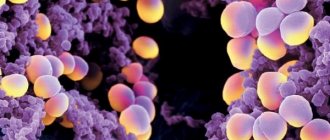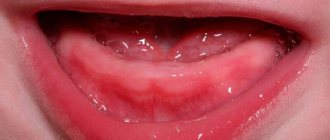Ultrasound for lactostasis is an effective physiotherapeutic method for eliminating milk stagnation when breastfeeding a child.
It helps nursing mothers get rid of breast problems without waiting for the situation to worsen.
Sometimes one or two sessions of such therapy are enough for a woman to feel relief.
Why does it occur
What is lactostasis? Why might he appear at all? There are a number of reasons that cause this condition. One of the main ones is improper attachment of the baby to the breast. The baby should be turned to face the mother's chest, the head and torso should be located in the same plane. The baby's mouth should cover most of the areola. If the baby is attached to the breast correctly, the mother does not feel pain. The only exception is the first stages of feeding. If the baby is not applied correctly, the breast will not empty completely. As a result, breast milk may stagnate in the ducts. This condition is called lactostasis.
Another common reason for stagnation of milk is feeding the baby not on demand, but by the hour. Milk may come in, but it does not reach the baby. As a result, lactostasis occurs.
Who is not suitable for treatment?
Despite the undoubtedly positive effect on the body, ultrasound cannot be used by everyone.
This treatment is contraindicated for those who:
- Suffers from various diseases of the nervous system.
- For malignant tumors.
- For mastopathy. Ultrasound treatment in this case can lead to the formation of cancer cells.
- Suffering from fibroadenoma of the mammary glands.
If there are no such health problems, ultrasound will be a real salvation for milk stagnation.
Experts have proven that the use of ultrasound is absolutely safe, so no matter how many procedures a woman has to undergo, she need not be afraid that this will negatively affect her future condition.
Ultrasonic waves transform stagnant masses of milk into an emulsion, thereby improving outflow. This allows you to get rid of the symptoms of lactostasis in a short period of time. That is why ultrasound treatment is the best solution to this problem.
Lactostasis, unfortunately, is not uncommon in women during lactation. It is a condition of the lactating breast in which the processes of milk formation and milk flow are disrupted.
Most often, it occurs 3-4 days after the birth (although it can appear at any stage of feeding) of the baby in mothers who do not breastfeed, put the baby to the breast too rarely and do not express milk.
This article will talk about why lactostasis occurs, how it manifests itself, what to do about it, how to prevent it, and also about the importance of physiotherapy for lactostasis.
Other reasons
There are also a number of negative factors that can cause lactostasis in a nursing mother. Treatment may depend on the causes of the disease.
Breast milk stagnation usually occurs as a result of the following conditions:
- Infectious diseases of the respiratory tract in the mother (the reason in this case is also tissue swelling).
- Hyperlactation (increased milk content in the mammary glands). This condition usually develops as a result of irrational frequent pumping.
- Swelling of the breast tissue can occur when wearing incorrectly selected underwear. The seams of your bra can put excessive pressure on you.
- Breast injury (tissues in the area of impact may swell, the ducts become compressed, and milk does not drain as expected).
- Anatomical features: in many women, the ducts of the mammary glands are too narrow or excessively tortuous.
- Sagging breasts.
- Sleeping on your side or stomach with compression of the mammary glands.
- Physical overexertion.
- Psycho-emotional stress.
Stagnation of milk in the duct can cause an increase in pressure in the entire lobule. As a result, tissue swelling occurs, which can turn into painful compaction. Milk, having no outflow tract, can be partially absorbed into the blood. This causes an increase in body temperature. Due to prolonged hypertension in the lobules, milk production is reduced until lactation completely stops. This condition is called total lactostasis.
Detected disorders and their ultrasound signs
Mastitis
It is an inflammation of the mammary glands. Most often, this disease occurs during lactation.
- It begins with lactostasis and serous stage. At this time, ultrasound can detect swelling of the gland parenchyma by increasing echogenicity. The expansion of the milk ducts and lymphatic vessels is also determined. The differentiation of parenchyma structures is impaired. The skin over the breast may thicken. This stage is characterized by soreness, slight redness and enlargement, and impaired milk flow. The period of serous inflammation can be final if treatment is started in a timely manner, as well as with mandatory complete expression of milk.
- In the infiltrative form, focal inflammation (leukocyte infiltrate) is formed, so ultrasound will already reveal a local increase in echogenicity. This form of mastitis can be indicated to a woman by the presence of pain and localized thickening, determined by palpation of the mammary gland.
- Regarding the purulent-destructive stage, ultrasound diagnostics may no longer have such a high value, since the clinical picture is quite indicative: sharp pain, bright red or bluish coloration of the skin, a symptom of fluctuation. Signs of general intoxication are also very pronounced (high body temperature, weakness, disturbances of consciousness, etc.). Ultrasound allows you to verify the diagnosis, determine the extent of the process and the presence of vascular disorders (thrombosis in the gangrenous form), and conduct differential diagnostics. A sharp change in the structure of the gland, low echogenicity of the lesion, dilated milk ducts are determined (the norm is up to 1-2 mm).
- An abscess forms less frequently, with sluggish and prolonged inflammation. In this case, ultrasound reveals a hypoechoic area of purulent melting, around which a capsule later forms.
Mastopathy
This is a disease of the mammary gland associated with disturbances in the hormonal status of a woman. In this regard, the balance between glandular tissue and stroma changes, corresponding to age and functional state. In addition, the normal structural organization is changed. Mastopathy can be diffuse and nodular. With this disease, pain and engorgement of the mammary gland are possible, which are reversible.
Diffuse mastopathy can be cystic, fibrous and mixed.
- The first type involves the appearance of cysts, which become benign neoplasms of the glandular epithelium. The structural histological organization of the parenchyma in this place is disrupted. In this case, ultrasound reveals a cavity (or several) with liquid contents. Cysts can reach significant boundaries.
- The fibrous form is the growth, on the contrary, of the stroma. It becomes dense and uneven. Using ultrasound, hyperechoic foci distributed throughout the gland are detected.
- Fibrocystic implies the presence of signs of the previous two forms.
on the echogram - multiple cysts and proliferation of connective tissue
Nodular mastopathy can be the result of the proliferation of numerous tissues present in the gland. Therefore, echogenicity depends on the nature of the node (lipoma, angioma, fibroadenoma, etc.). Ultrasound diagnostics determines the focus of altered density, its size and prevalence, and the nature of its boundaries.
Malignant neoplasms
Of these, breast cancer is the most common
It is of extreme importance, as it ranks second in frequency among cancer problems in women, second only to skin diseases (including melanoma). The difficulty also lies in the “rejuvenation” of the disease
echography can visualize small tumors
Ultrasound for breast cancer reveals a focus with reduced echogenicity. Unlike benign neoplasms, it has infiltrating growth, which is why the boundaries of the lesion are unclear and its shape is irregular.
In addition, ultrasound examination reveals enlarged lymph nodes (if they have metastases). Ultrasound is necessary to determine the extent of the process (size, presence of regional and distant metastases). When a lesion is detected, it is necessary to conduct cyto- and histological studies, only after which a diagnosis of a malignant process is established.
Symptoms
Let's look at this in more detail. It is not difficult to identify this condition. The first thing a woman usually notices is pain in a certain area of the breast. Along with this, a feeling of heaviness and distension arises. When palpated, a painful lump may appear. There may also be an increase in temperature to subfebrile (37-38 degrees) and febrile (38-39) values. The disease may be accompanied by a state of chills. Many sick mothers first notice weakness, and only then pay attention to the elevated temperature, and after that they try to find the cause of this condition. Even at home, a woman may well palpate a painful lump deep in the mammary gland.
It should be noted that not every mother will be able to independently detect a lump. In this case, you need to consult a doctor. Some women don't even have a fever. With lactostasis, feeding is accompanied by severe pain. Over time, the lump may increase in size and the skin over it may turn red. If the woman is not given medical assistance at this stage, an infection may develop in the stagnant milk. As a result, mastitis develops. This can lead to the accumulation of pus in the mammary gland.
What will help eliminate the risk of disease
If the first signs of lactostasis appear, you should consult a doctor and begin ultrasound treatment. At the same time, you should take your own measures to eliminate the disease:
- Carefully monitor the feeding process and how much milk the baby is able to suck. The remaining milk must be expressed immediately.
- Additional feeding of a baby from a bottle is not recommended. This causes him to develop an incorrect latch on the nipple when feeding.
- The baby is often applied to the affected breast, but you should not use the healthy breast, so as not to cause a similar phenomenon in it.
- Taking a warm shower before breastfeeding helps your milk flow easier.
- A woman’s body should not be allowed to become dehydrated. You need to drink at the first feeling of thirst, without artificial restraint.
Lactostasis in a nursing woman can cause serious consequences.
It needs to be identified and treated at an early stage. Ultrasound therapy is one of the effective forms of combating this phenomenon. This procedure is considered absolutely safe, and a positive effect is achieved after 3-4 sessions.
Lactostasis is the phenomenon of milk stagnation in the milk ducts. When one or more ducts become blocked, stagnation occurs. The breast in this place becomes denser, and over time pain occurs. The combination of signs suggests that the inflammatory process has already begun. Delay in treatment of stagnation leads to an increase in the area of inflammation and spread of the disease to the entire mammary gland. Untreated lactostasis develops into mastitis.
Mastitis in the first stage has the following distinctive characteristics: swelling, tenderness of the breast and high fever. This stage is a reason to immediately consult a specialist, namely a mammologist. If you don't do this on time, you risk making the problem worse. Various pathogens, such as staphylococci and streptococci, begin their harmful effects: purulent abscesses appear. This severe form of mastitis is called purulent and in most cases can only be treated through surgery, when all abscesses are opened.
Therapy
What is lactostasis and how to treat it? To eliminate this disease, experts recommend that nursing mothers express milk using a breast pump. First of all, it is worth noting that in case of stagnation in the early stages, a woman can cope with the problem on her own. It is enough to simply put the baby to the breast. The simplest method of treating milk stagnation is frequent feeding. However, you must ensure that they are correct. Then the manipulations discussed will be more effective. The baby should be positioned so that his chin is directed towards the seal. Thanks to this, additional massage will also be provided. If there is congestion in the upper segments, it is recommended to place the baby upside down. In this case, the young mother will have to try hard, but the result will not be long in coming.
What to do at the first signs of lactostasis?
Physiotherapy is prescribed in advanced cases when there is a threat of mastitis.
To avoid this condition of the mammary glands, you must:
- Monitor feeding technique: the baby must latch onto the breast correctly and should be applied to the sore breast more often.
- During feeding, it is necessary to massage the breasts to completely empty them of milk.
- You can’t pump too often, otherwise more milk will come in and the condition of the mammary glands will worsen even more.
- Before feeding, you need to put a warm diaper on your chest. This must be done in order to improve milk flow.
- When expressing, you need to try to free the areas of compacted mammary glands from milk as much as possible.
If you were unable to correct the situation on your own, you should contact a specialist as soon as possible. The hospital will prescribe the necessary medications, physical therapy, and help you express your sore breast.
Recommendations
Is it possible to somehow prevent lactostasis (ICD-10 code 091 - mastitis)? Many qualified professionals recommend taking a warm shower before feeding. Water jets should be directed to the area between the blades and to the area where the compaction is localized. Warm jets of water will provide a kind of massage, as a result of which the ducts and muscles that are in a state of spasm will be relaxed. You can also try using a compress instead of a shower. It is applied for 15-20 minutes before the intended feeding.
Experts recommend using compresses with camphor alcohol. However, it is worth noting that this remedy can reduce the level of lactation. Restoring the original condition can be extremely difficult. This method is completely justified and can be used if lactostasis is caused by hyperlactation.
Before and after feeding, doctors advise doing a gentle massage. Previously, it was believed that stagnation of milk in the breast could only be “broken,” thereby causing excruciating pain to the young mother. Such a massage often left behind many bruises. Too harsh mechanical impacts can cause swelling of the delicate breast tissue, which will subsequently lead to a whole series of lactostasis.
Detected disorders and their ultrasound signs
Treatment is prescribed after assessing the results of the study. Diagnostically confirm or refute mastitis, mastopathy, and the formation of malignant tumors. In the latter case, additional examinations may be required.
Pathology is detected based on changes in echogenicity - the ability to absorb and reflect ultrasonic waves.
Mastitis
In the absence of timely treatment, inflammation of the mammary glands can progress from lactostasis to the purulent stage.
At the initial stage, swelling of the parenchyma (gland tissue consisting of many alveoli that are located around the milk duct) and increased echogenicity of this area, thickening of the skin in the chest area and expansion of the ducts are detected.
At the infiltrative stage, with the formation of a localized focus of inflammation, echogenicity will increase in the affected area. The patient's complaint was pain on palpation of the lump.
With purulent inflammation, the diagnosis is made based on the clinical picture. The mammary glands are swollen, the skin is bluish-purple, the pain is sharp when touched. Symptoms of general intoxication appear - weakness, fever, nausea. Ultrasound at this stage is performed to identify thrombosis (vascular pathology) and determine the boundaries of the area of the purulent process. The echogenicity of the affected area decreases, the milk ducts dilate.
Mastopathy
This term refers to the pathological proliferation of glandular tissue of the mammary gland, the symptoms of which are: pain on palpation, heaviness in the chest and the appearance of benign neoplasms. If the disease manifests itself during pregnancy, then after childbirth, during the period of hormonal restoration, the condition returns to normal.
If the regeneration of hormonal levels is slow, then against the background of a rush of milk, lactostasis occurs, which prevents breastfeeding. Once the causes are established, breast engorgement can be stopped.
During lactation, diffuse mastopathy can occur in several forms. In cystic, individual cysts are detected in the glandular tissue and structural localized foci - encapsulated cavities with liquid contents. With fibrous, the stroma (connective tissue) grows and a change in echogenicity is detected in foci distributed along the ducts. The mixed form - fibrocystic - includes all the symptoms.
The change in echogenicity in nodular mastopathy depends on the nature of the pathological changes. Thanks to ultrasound, it is possible to determine the location of the tumor, the density and structure of tissues, and boundaries.
Malignant neoplasms
Changes in echogenicity can reveal the onset of malignant transformation at an early stage. In pathological foci, echogenicity decreases, the emerging neoplasms are irregular in shape, and the boundaries are unclear. Changes in the lymph nodes are possible.
In this case, ultrasound is not a basis for referral for treatment. A biopsy procedure is performed to confirm the diagnosis.
Ultrasound
Traditional methods of treating milk stagnation are not always effective. Therefore, many are interested in how ultrasound is used for lactostasis.
This technique has many advantages:
- Ultrasonic influence is applied directly to the area of compaction. Not all restoration techniques have this feature.
- Ultrasound on the mammary glands during lactostasis does not cause any harm to soft tissues and other structures.
- The impact on milk stagnation is carried out through micro-type massage.
In tissues treated with ultrasound, improved blood circulation and accelerated metabolic processes are also observed. This has a positive effect on all functions of the young mother’s body.
Treatment methods for lactostasis
Treatment of lactostasis must begin immediately after the first symptoms of inflammation are detected.
Usually, to treat this disease, doctors prescribe physical procedures that help:
- remove a lump in the mammary gland;
- expand the milk ducts;
- activate the movement of blood and lymph;
- have anti-inflammatory, analgesic and antispasmodic effects.
In inpatient and outpatient treatment settings, the following methods of combating lactostasis are most popular:
- ultrasound therapy;
- magnetic therapy;
- treatment with the Darsonval apparatus;
- Exercise therapy.
Ultrasound therapy
Ultrasound therapy is a treatment technique using ultrasound.
When using ultrasound technology, the milk ducts expand due to the warming effect of the device. The effectiveness of ultrasonic exposure is achieved at 0.2–0.4 W. Relief in the mammary gland is observed after two ultrasound sessions, which last on average about 15 minutes. The course of treatment usually includes 8–10 sessions and is carried out by a qualified specialist.
The ultrasound device is completely painless and does not cause discomfort to the nursing mother.
After the ultrasound therapy procedure, it is necessary to express milk yourself, but feeding it to the child is strictly prohibited.
Magnetotherapy
Magnetotherapy is a treatment method that uses the effect of a magnetic field on the human body. The magnetic therapy procedure can be carried out independently at home using the AMT-01 device. But before starting treatment, you must consult your doctor.
You can carry out magnetic therapy procedures right at home using a special device.
The magnetic field indicator is placed over the area of the seal, without affecting the areola area. At the first session, the magnetic field induction should be 300–600 mT, and then with a gradual increase it should reach 1000 mT. To completely cure lactostasis, you may need from 5 to 10 procedures, each of which is carried out once a day and lasts for 5 minutes.
In my family, the AMT-01 magnetic therapy device is often used. My mother uses it for high blood pressure, headaches and back pain, and also used it intensively for a dislocated shoulder joint. I used this device to disperse accumulated fluid in the knee joint, which was formed as a result of an impact. This treatment method was recommended to me by a surgeon.
Treatment with the Darsonval apparatus
The treatment method with the Darsonval apparatus is based on a dosed supply of electric current to the areas of compaction, the resorption of which occurs due to mechanical, physical and thermal effects. This method helps to cope even with advanced stages of lactostasis.
Treatment with the Darsonval apparatus is possible only after a thorough examination by a gynecologist and an ultrasound scan, which will help exclude tumor processes and mastopathy.
To treat lactostasis using the Darsonval apparatus, a mushroom-shaped attachment is used.
When treating lactostasis, a special mushroom-shaped attachment for the Darsonval apparatus is used
One treatment session with Darsonval at minimal or medium power is 10 minutes. To achieve maximum results, 10–15 procedures are required. There is no need to stop lactation during treatment with the device.
Before the darsonvalization procedure, it is necessary to protect the area of the nipples and areolas from the effects of electric current pulses. To do this, you need to fold a piece of gauze measuring 15x15 cm into four and apply it to the most sensitive area of the breast. You can also use a cotton pad for this purpose.
Exercise therapy
Therapeutic physical education (PT) is a medical method in which physical exercises are used for the treatment and prevention of various diseases.
A nursing woman needs exercise therapy for both the prevention and treatment of lactostasis. The main condition for performing the exercises is the absence of pain and discomfort. You need to do the exercises 1-2 times a day before feeding.
Exercise to prevent lactostasis
To prevent the appearance of lumps in the breasts, it is necessary to regularly perform exercises aimed at maintaining the muscles of the breast in tone.
Technique for performing exercises to prevent lactostasis:
- Raise your arm up and bend it at the elbow joint. In this case, the forearm should be placed parallel to the floor.
- Place the heel of your forearm on the door frame.
- Bend the leg of the same name slightly at the knee joint and place it as close as possible to the door frame.
- Perform springy movements towards the jamb, while tensing the pectoral muscles as much as possible.
Perform the exercise 1-2 times a day before breastfeeding your baby. The intensity and strength of movements, as well as the bend angle and height of the hand relative to the jamb must be constantly changed.
Exercises to treat lactostasis
Technique for performing exercise No. 1 for the treatment of lactostasis:
- Raise your arm up and bend it at the elbow joint. In this case, the forearm should be placed parallel to the floor.
- Place the heel of your forearm on the door frame.
- Bend the leg of the same name slightly at the knee joint and place it as close as possible to the door frame.
- Using the fingers of the opposite hand, grasp the lump in the mammary gland.
- Perform springy movements towards the jamb, while tensing the pectoral muscles as much as possible and pulling down the area of the seal.
- If your fingers slip off the seal, grab it again.
The exercise must be performed 3-4 times a day. The intensity and strength of movements, as well as the bend angle and height of the hand relative to the jamb must be constantly changed.
Technique for performing exercise No. 2 for the treatment of lactostasis:
- Make both hands into a fist and place them towards your shoulders.
- Spread your elbows to the sides.
- Rest your elbows on the door frames, place your feet shoulder-width apart.
- Using springy movements, press your hands on the joint for 5 seconds.
- Sag in the doorway, stretching the muscles that run from your chest to your elbows.
Repeat the exercise 3-4 times, then move your elbows first higher and then lower on the doorframe and repeat the exercise.
As a result of the exercises described above, the lump in the mammary glands should become much softer and decrease in size.
If no improvement is observed within two days after performing physical therapy exercises, you should seek help from a gynecologist, mammologist or osteopath. The latter, as a rule, helps to cope with the disease in one session.
Features of the technique
The use of ultrasound in medicine has become quite widespread. It consists of exposure to frequency fluctuations up to 3000 kHz, which must be strictly dosed. Ultrasound can only be used under the supervision of a mammologist. He will be able to determine all the features of a woman’s condition.
Due to the influence of ultrasonic waves, mechanical, thermal and physico-chemical effects can be achieved. In essence, the presented technique plays the role of an irritant that can trigger the body’s natural defense mechanisms. As a result, accelerated tissue regeneration is observed.
Is ultrasound effective for lactostasis? Reviews from patients confirm that pain goes away quite quickly when using this technique.
How is milk stagnation treated with ultrasound?
Since ultrasound is considered an active physical factor that has a multifaceted effect on the body, it is more than appropriate to use it when treating such a condition as lactostasis.
For lactostasis, such treatment is prescribed because this physiotherapeutic technique is an adequate (correct) physical and chemical stimulus, which can trigger various mechanisms that help bring the internal environment of the body to its normal conditions. This triggers all the body’s natural defenses, which ultimately helps to quickly resolve problems with milk stagnation.
Lactostasis is treated using this technique also because the effect of ultrasound accelerates tissue regeneration processes, promotes the resorption of infiltrates, the disappearance of traumatic edema, various exudates, etc.
Standard effects of ultrasound therapy for the diagnosis of lactostasis are carried out, without fail, through a special contact medium, which excludes the presence of air directly between the working surface of the vibrator and the skin surface of the treatment.
How treatment is carried out using ultrasound can be clearly seen in the video. At the same time, it is important to say that the reviews of the patients themselves, suffering from stagnation of breast milk after the procedure, are always only the most positive. PAPILLOMAS, WARTS AND HERPES, as well as FLU and ARVI.
How can you identify them?
- nervousness, sleep and appetite disturbances;
- allergies (watery eyes, rashes, runny nose);
- frequent headaches, constipation or diarrhea;
- frequent colds, sore throat, nasal congestion;
- pain in joints and muscles;
- chronic fatigue (you get tired quickly, no matter what you do);
- dark circles, bags under the eyes.
Lactostasis is the stagnation of breast milk in the ducts of the mammary gland of a nursing mother. This condition can occur at any stage of breastfeeding - immediately after the birth of the baby, and a year later; It may occur once, or it may recur periodically at least every month. Lactostasis not only causes significant discomfort to a woman, but can also pose a threat to breastfeeding, and, when complicated, the health of a young mother. The complex treatment of lactostasis also includes physiotherapeutic techniques. Our article will discuss why milk stagnation occurs in the breast, what are the clinical manifestations of this condition, as well as methods of its treatment, including physiotherapy.
Contraindications
This issue deserves special attention. Despite its high efficiency, ultrasound cannot always be used for lactostasis.
Mammologists identify the following contraindications to such physical procedures:
Less serious contraindications include hormonal disorders. The problem is that some of their forms lead to the development of cancer. Therefore, in this case, ultrasound cannot be used for lactostasis. Contraindications also include cystic diseases (mammary fibroadenomatosis).
When is ultrasound recommended?
For preventive purposes, women should undergo breast ultrasound every year. An urgent procedure is prescribed if:
- pregnancy or lactation occurs (if necessary);
- a woman feels discomfort in the mammary glands;
- there are cancers in the hereditary line (mother or grandmother or there is a predisposition to such diseases);
- inflammation was detected;
- upon palpation, a thickened area of the chest is felt;
- mammography results need to be rechecked;
- the woman needs to check the condition of the implants; a breast injury or displacement may have occurred;
- upon visual examination, nodes or a cyst are observed, reddened areas of tissue are found, swelling or pain is felt in the chest;
- discharge from the chest occurs from time to time;
- the disease was identified earlier and it is necessary to look at its progress or dynamics;
- nipples have changed their appearance;
- there is fever, fever, feeling unwell, but the woman’s other organs are not bothered;
- Mechanical chest injuries were identified;
- it is necessary to take a puncture;
- the mammary glands have increased in volume for no obvious reason or their density has changed sharply;
- you need to choose hormonal drugs for contraception;
- diseases have also been identified in the field of gynecology, in particular the ovaries;
- a woman needs to check her health at the stage of menopause;
- enlarged lymph nodes in the armpit area;
- there is reasonable suspicion of the development of a cyst or papillomas on the chest;
- a more detailed transcript of the data from another study is needed;
- it is necessary to determine how far the lesion spreads;
- concomitant diseases have already caused significant changes in other organs;
- it is necessary to monitor the prescribed treatment;
- it is necessary to conduct an examination of the circulatory system.
As a rule, ultrasound is performed as directed by a doctor or when a woman is planning pregnancy or breast surgery.
At home
What is lactostasis? Is it possible to fight this condition at home? Doctors strongly advise the use of special complexes of vitamins and minerals. These drugs will help improve the general condition of the young mother.
How is mastitis treated in a nursing mother? Let us repeat, 091 is the ICD-10 code for lactostasis. The most effective technique is ultrasound. If you follow a number of recommendations, it can be used even at home. Some preparation is required. First, you should stop taking hormonal medications. It is also not recommended to drink alcohol before the procedure. This can worsen the general condition of the body and will minimize the therapeutic effect of treatment.
In order for ultrasound to be as effective as possible for lactostasis, it is recommended to massage the breasts with soft relaxing movements before the procedure. This will speed up the process of milk absorption.
Preferred feeding positions
Each mother makes her own choice of a comfortable position when breastfeeding. It is influenced by a number of factors:
- Child activity.
- Woman breast shape.
- Individual preferences of both.
However, there are several positions that are better than others for feeding children with lactostasis:
- "Cradle" The woman sits in a position that is comfortable for herself, puts the baby on her tummy, and places his head on the bend of the elbow. The position is as comfortable as possible for the child, as it provides him with a position in the mother’s arms similar to the one in which he lies in the cradle.
- Underhand feeding position. The mother places her baby on the pillow under her arm, turning his face to his chest. The convenience of the position for a newborn lies in the fact that it is convenient for him to grasp the mother's breast, and for the mother - there is no pressure on her stomach.
- Both are on their sides. The woman and her child are positioned on their sides opposite each other, face to face. The best position for lactostasis, since the affected breast does not experience any pressure, and the location of the second breast is physiologically correct. The best reviews from mothers concern this position.
Note:
There are other positions suitable for feeding with lactostasis, but those listed above are the most effective and help fight this pathological condition with the help of a newborn.
What positions are comfortable when feeding a baby, see the following video:
It is necessary to understand that physiotherapy, in general, and ultrasound therapy, in particular, for such a diagnosis as lactostasis, is used as widely as possible today.
And all because physiotherapy is considered an effective direction, representing the traditional treatment of this condition.
Ultrasound for lactostasis, as a therapeutic method, allows you to quickly get rid of emerging lumps in the breast, preventing the development of a more complex infectious process.
Another significant advantage of such physiotherapeutic treatment as ultrasound can be the complete absence of any pain or discomfort, and, of course, complete safety for a nursing woman.
Today, quite often, women facing congestion in the chest due to lactostasis are recommended to undergo several sessions of ultrasound therapy. At the same time, ultrasound easily and quickly allows you to eliminate congestion during lactostasis, and at the same time fight cracks and microtraumas in the nipple area.
The essence of the procedure
With lactostasis, stagnation of milk occurs, which causes unpleasant and painful sensations. This leads to tissue swelling and can cause inflammation.
This can happen if:
- A young mother, due to lack of experience, cannot properly attach her baby to the breast.
- There are long breaks between feedings, and the baby does not suck all the milk.
- A woman wears tight underwear, which injures her breasts, or sleeps on her stomach, which causes compression of the milk ducts.
- The baby cannot latch on.
This disease is so common because after the baby is born, milk comes in suddenly and in large volumes, and the baby is not able to empty the breast. It is this period that is especially dangerous, and how long it will last depends on the woman.
Ultrasound works in this way:
- Milk liquefies in the mammary glands.
- Its outflow improves.
- Blood circulation improves.
- It has an anti-inflammatory effect, which helps prevent mastitis.
- Fights cracks and microtraumas in the nipple area.
Treatment of the mammary glands involves the use of a special device emitting ultra-high frequencies of the order of up to 3000 kHz. The procedure should be performed by an experienced professional.
Experts believe that several stages of the impact of ultrasound on the body can be distinguished:
- The first stage is the impact itself, during which microscopic restructuring of cellular structures is observed.
- The second stage begins a few hours after the procedure. An increase in the protective functions of leukocytes can be observed.
- The third stage is characterized by increased metabolism in tissues.
- At the last stage, carbohydrate metabolism increases and blood circulation improves.
How many procedures will have to be done depends on the degree of development of the disease. Treatment must be done every day. Usually a woman needs to do 5-8 procedures. One session lasts only 15 minutes. After its completion, the woman must express breast milk. This will be very easy, as ultrasound clears the milk ducts. This milk cannot be used to feed a baby.
The treatment does not cause any discomfort. A special device allows you to gently influence the breasts, creating the effect of a pleasant massage, in which the woman feels only relaxing, pleasant warmth.
It may be painful when pumping after the procedure. But its intensity is much lower. It can’t be compared to what a woman feels when trying to strain at home without resorting to treatment.
Ultrasound for lactostasis is actively used all over the world. It allows you to quickly improve the condition of the mammary glands. You don't need to do many procedures for healing to occur. You feel better after just two or three sessions.
The essence of the procedure
With lactostasis, stagnation of milk occurs, which causes unpleasant and painful sensations. This leads to tissue swelling and can cause inflammation.
This can happen if:
- A young mother, due to lack of experience, cannot properly attach her baby to the breast.
- There are long breaks between feedings, and the baby does not suck all the milk.
- A woman wears tight underwear, which injures her breasts, or sleeps on her stomach, which causes compression of the milk ducts.
- The baby cannot latch on.
Ultrasound works in this way:
- Milk liquefies in the mammary glands.
- Its outflow improves.
- Blood circulation improves.
- It has an anti-inflammatory effect, which helps prevent mastitis.
- Fights cracks and microtraumas in the nipple area.
Treatment of the mammary glands involves the use of a special device emitting ultra-high frequencies of the order of up to 3000 kHz. The procedure should be performed by an experienced professional.
Experts believe that several stages of the impact of ultrasound on the body can be distinguished:
- The first stage is the impact itself, during which microscopic restructuring of cellular structures is observed.
- The second stage begins a few hours after the procedure. An increase in the protective functions of leukocytes can be observed.
- The third stage is characterized by increased metabolism in tissues.
- At the last stage, carbohydrate metabolism increases and blood circulation improves.
How many procedures will have to be done depends on the degree of development of the disease. Treatment must be done every day. Usually a woman needs to do 5-8 procedures. One session lasts only 15 minutes. After its completion, the woman must express breast milk. This will be very easy, as ultrasound clears the milk ducts. This milk cannot be used to feed a baby.
The treatment does not cause any discomfort. A special device allows you to gently influence the breasts, creating the effect of a pleasant massage, in which the woman feels only relaxing, pleasant warmth.
It may be painful when pumping after the procedure. But its intensity is much lower. It can’t be compared to what a woman feels when trying to strain at home without resorting to treatment.
Ultrasound for lactostasis is actively used all over the world. It allows you to quickly improve the condition of the mammary glands. You don't need to do many procedures for healing to occur. You feel better after just two or three sessions.
Traditional Treatments
As a rule, the operation is performed under general anesthesia. This is either intravenous administration of short-acting anesthetics or inhalation anesthesia. Local anesthesia is used only for small, shallow abscesses.
During the operation, a radial incision is made over the affected area, the pus is removed and the existing partitions are destroyed to form a single cavity, which is easier to treat with antiseptic solutions. If necessary, a counter incision (counter-aperture) is made for better drainage of the cavity. After treating the wound, stitches are applied to ensure faster healing. If there are doubts about the viability of the remaining tissues, I apply sutures some time after the operation.
In the postoperative period, ointment (Levomekol) is applied to the wound and physiotherapy is carried out in combination with antibacterial therapy.
If the abscess is located in the area of the areola of the nipple, then the incision is made 2–3 cm from the edge of the areola, parallel to it.
When the inflammatory process is localized in the tissue located behind the mammary gland (retromammary abscess), an incision is made along the transitional fold between the chest wall and the gland. Thanks to this, the consequences of the operation are almost invisible and there is less chance of injury to the milk ducts.
The disadvantages of such treatment methods are: high trauma, long treatment period, cosmetic defects, disruption or complete cessation of lactation.
Minimally invasive treatment methods
Such methods of treating mastitis do not have the disadvantages that are inherent in traditional surgery. Under ultrasound control, a puncture is made and catheters are installed through which the purulent focus is drained. There may be only one catheter. Sometimes 2 drainage tubes are installed.
Manipulations are carried out on an outpatient basis. The duration of treatment is no more than a week. The advantages of the method are its low invasiveness, rapid recovery and preservation of lactation. With this method of treatment, there is no need to take antibacterial drugs orally.
Physiotherapeutic effects
Physiotherapy techniques are aimed at fighting infection, reducing swelling and restoring breast tissue.











